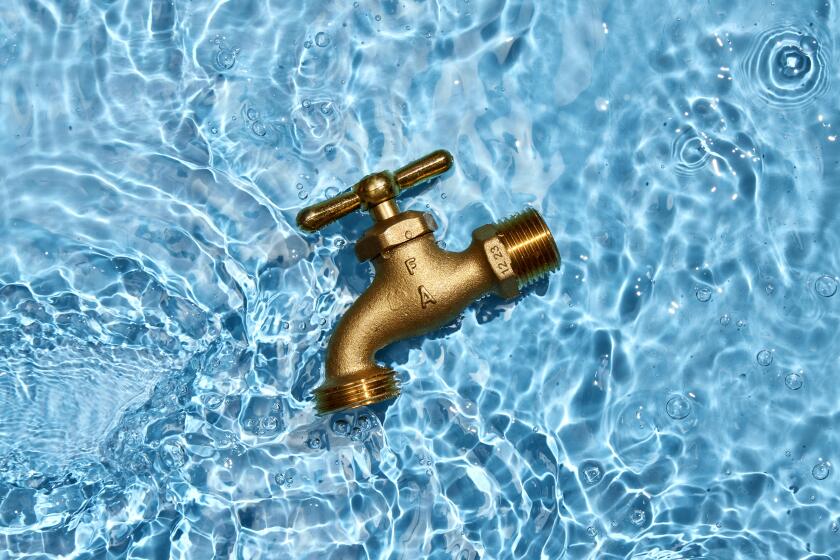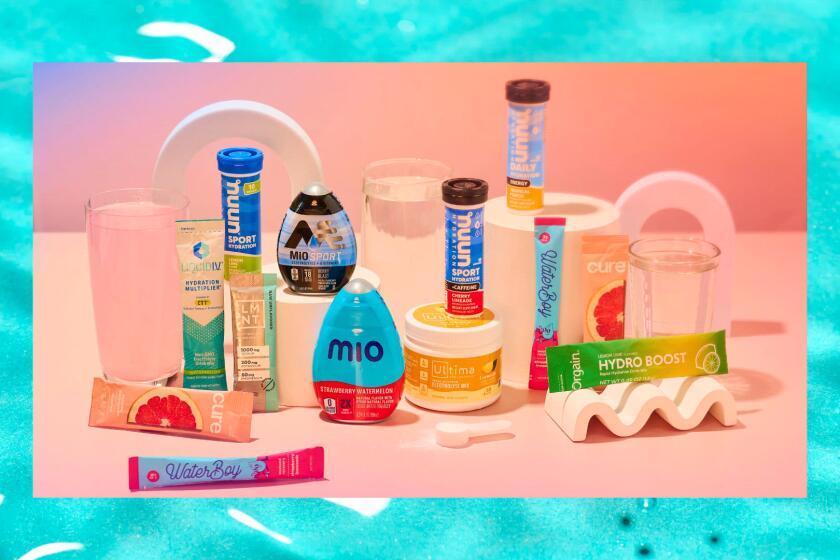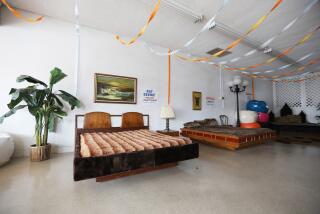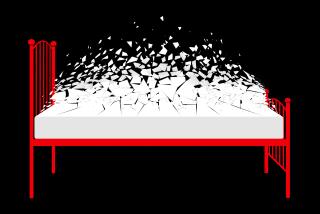
- Share via
The bed in Nancy Gerrish’s bright Los Feliz home appears perfectly normal — carved wooden headboard, fuzzy brown blanket, cream-colored bed skirt. The sheets are a tasteful leopard print. A few brocade throw pillows lie atop the spread to complete the earth-tone look.
But beneath that plush exterior, Gerrish’s bed hides a jiggling secret.
Sit on the mattress’ edge and it wobbles and undulates. Lie down and it rocks gently, as if you’re floating above a temperate pool of water.
And indeed, you are.
In L.A., water rules everything around us. Drink up, cool off and dive into our stories about hydrating and recreating in the city.
“I tell people I have a waterbed, and everyone laughs,” says Gerrish, 78, a financial planner with white curly hair and manicured lavender nails. “But it’s a very comfortable bed to sleep in, and I personally don’t know why the world doesn’t have this.”
If you thought waterbeds had gone the way of 1970s trends like Troll dolls and polyester pantsuits, you are mostly correct. The wavy vinyl mattresses that became a symbol of the era’s sex, drugs and rock ’n’ roll lifestyle may no longer be part of the collective consciousness except as the butt of a joke in a period film or as a forbidden item on a boilerplate apartment lease. But they can still be found gently rippling in a handful of Southern California bedrooms.
Waterbeds account for less than 2% of all mattress sales today, according to the Specialty Sleep Assn., but the few remaining retailers receive daily calls from stubborn holdouts like Gerrish — mostly older folks who bought a fluid-filled mattress decades ago, fell in love with its wavy motion and won’t sleep on anything else. Now, these waterbed enthusiasts scour the internet for replacement mattresses, heaters and water treatment systems, determined to resist sleeping on standard mattresses — what they call “dead beds” — for as long as they can.
“I worry,” said Donna Martin, 77, of Glendale, who has been sleeping in a waterbed for 50 years. “I think to myself if I ever have to go into a home, they won’t give me no waterbed.”

The ‘Pleasure Pit’ boom
The modern waterbed was invented in 1968 by Charles Hall, a graduate student at San Francisco State, as part of his master’s thesis in design. Hall, then 24, had originally set out to create the world’s most comfortable chair, filling a plastic sack with gelatin and then cornstarch with disappointing results. Eventually, he landed on a winning formula — an 8-foot water-filled square vinyl mattress. He called it the “Pleasure Pit” and imagined it as a bed-chair hybrid — the only piece of furniture one would need.
“It was new, it was exciting, it was different, it was sexy, it was fun. It was our generation’s bed.”
— Denny Boyd, former president of the Waterbed Manufacturers Association.
His prototype was featured in a show called “Happy Happenings” at the San Francisco Cannery art gallery that summer and articles about a new-fangled waterbed soon were appearing in newspapers and magazines across the country. A modern sleep trend was born.
“It was new, it was exciting, it was different, it was sexy, it was fun,” said Denny Boyd, former president of the Waterbed Manufacturers Assn., who once owned 35 waterbed stores throughout Texas, Missouri and Louisiana. “It was our generation’s bed.”
Waterbed sales skyrocketed from an estimated $13 million in 1971 to $1.9 billion in 1986, according to the New York Times. The mattresses were fairly cheap, but sales of the heavy wood frames that kept the mattresses from flopping around, plus water heaters and conditioners, brought in big bucks. By 1991, roughly 1 in every 5 mattresses sold in America was fluid-filled, according to the Washington Post. Hall received a patent for his invention in 1971 but rarely enforced it, and young entrepreneurs quickly turned the waterbed business into a lucrative industry.
We spoke to experts in the realms of science, academia and water filtration to help you navigate the often complicated, ever-fluid world of residential tap water, so that you can make smarter and more informed choices about how to purify your drinking water.
“There were a whole lot of people who were millionaires by the time they were 25,” Boyd said.
It was a wild, sex-soaked business. One early ad declared, “Two things are better on a waterbed. One of them is sleeping.” Boyd remembers hosting pajama party sales events at his stores where customers would show up in outrageous sleepwear — see-through nighties and G-strings. The store served wine and cheese and stayed open until 3 or 4 a.m.
“It was more than R-rated,” Boyd said.
Competition among the mostly male sales force was fierce. “People used to throw rocks at each other’s stores and look in dustbins to see client lists,” Boyd said. “At the trade shows, you had to hire a security guard to watch your space so people wouldn’t sneak back in and poke holes in your mattress.”
Hydration supplements are a booming business — but do these water additives really work? Doctors and nutrition experts weigh in.
By the mid-1990s, however, the party was over. After a precipitous rise, the waterbed market dried up. Boyd says the decline was due to a handful of factors, one of which was the advent of the “softside” waterbed mattress, which looked and felt more like a traditional bed and didn’t require pricy bed frames or special sheets — accessories that generated the bulk of the revenue for waterbed stores. At the same time, several new alternative mattress technologies hit the market, including airbeds, the Sleep Number, Tempur-Pedic and memory foam.
“These were more conventional beds, easier to sell and less complicated,” Boyd said. “They also had lots of advertising behind them.”
In 1995, the Waterbed Manufacturers Assn. rebranded itself as the Specialty Sleep Assn.
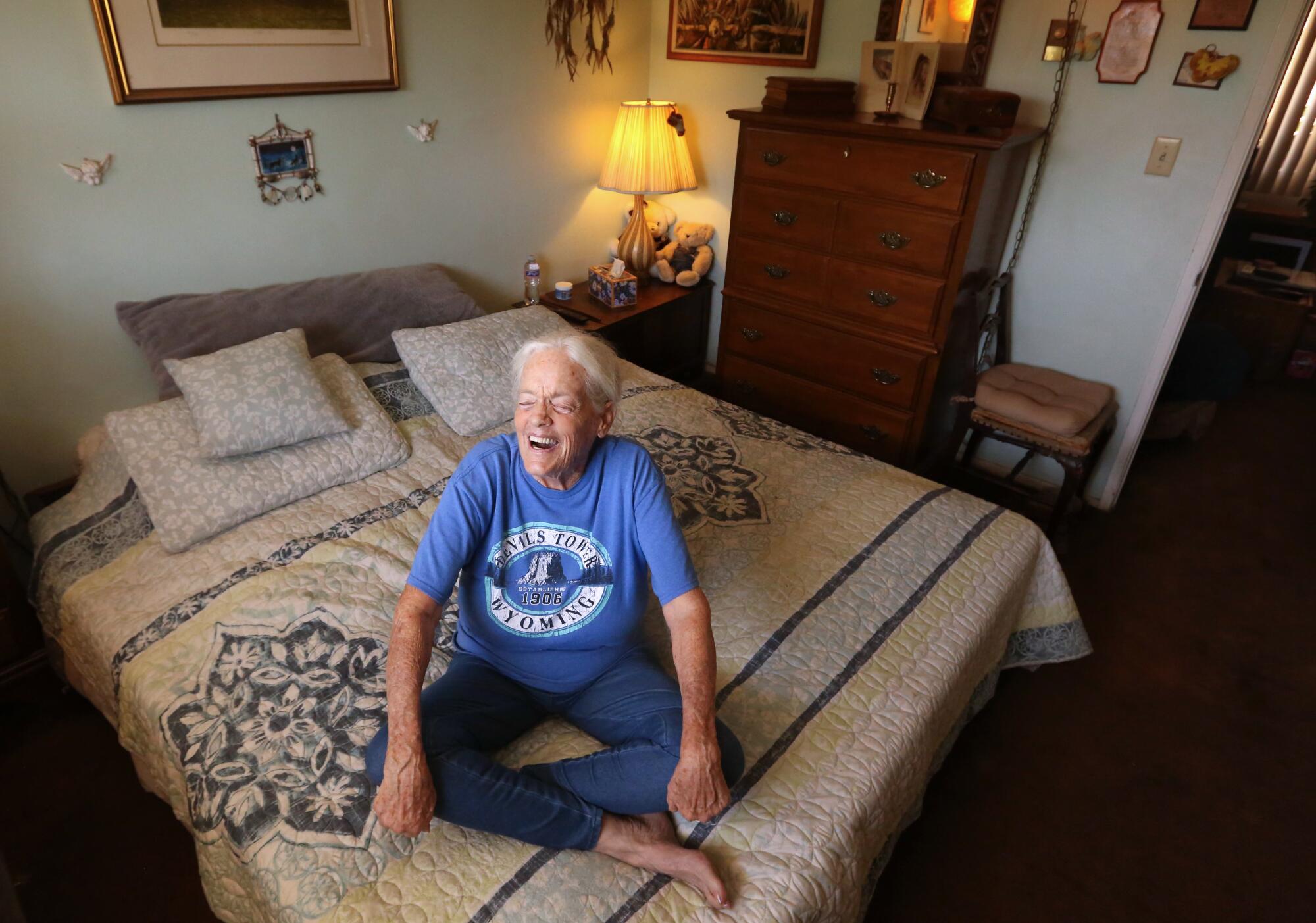
Dedicated ‘water heads’ remain
For some, the waterbed was never a passing trend. It‘s a lifelong devotion.
Gerrish, the financial planner from Los Feliz, bought her first water-filled mattress in 1996 after sleeping on a friend’s waterbed. “I couldn’t believe how comfortable it was,” she said. “It’s very soft on all your joints, and if you like to cuddle, your arm sinks into the bed so there’s no pressure on it.”
She moved her waterbed to Los Angeles from New York 21 years ago. When she eventually sells her Los Feliz home, she hopes to take it with her wherever she moves next. (She was relieved to learn that it is illegal for landlords to forbid waterbeds in California in rental units built after 1973, though they can require tenants to have insurance for damage caused by the bed.)
The local L.A. chain offers more than a dozen water brands from at least eight countries at affordable prices.
“I feel so cozy. It’s hard to get out of it,” she said. “And anyone visiting me loves it. I think the [traditional] mattress companies don’t want this information getting out.”
Gerrish has been sleeping on a water-filled mattress for 28 years, but several L.A. waterbed lovers have had an even longer relationship with Hall’s 1968 invention.
Martin, the 77-year-old in Glendale, has been sleeping on a waterbed since she got her first one as a hand-me-down from a friend.
“I’ve had five mattresses since the first time I set one up. I love it,” she said.
Recently, she slept on her sister’s Swedish memory foam mattress while taking care of her pets for the weekend. The verdict? No, thank you. Martin has a squashed disk in her spine and finds the waterbed is easier on her hips.
“At first it was OK, but then the same thing happened, too much pressure,” she said. “I would rather not sleep in something else.”
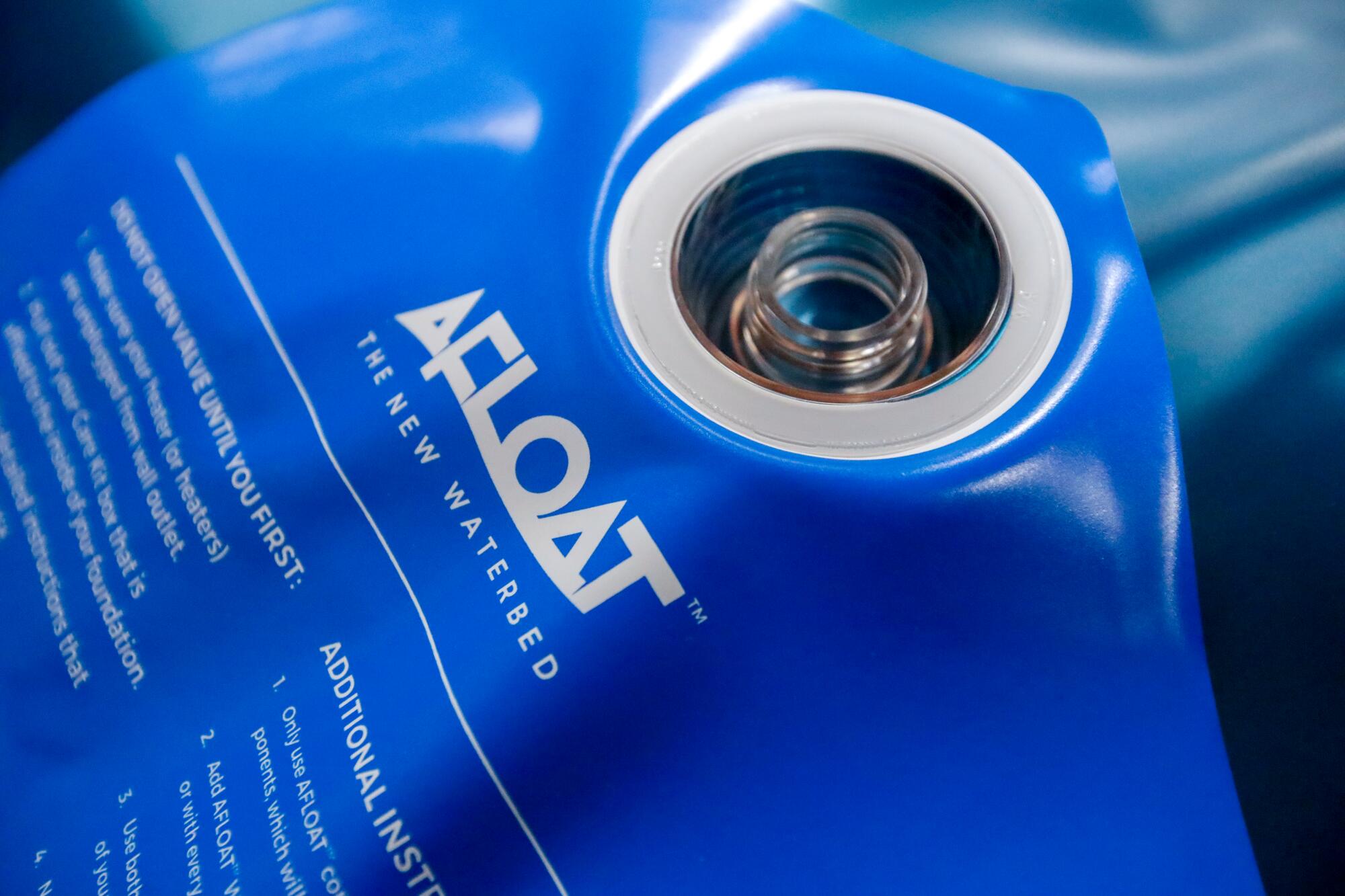
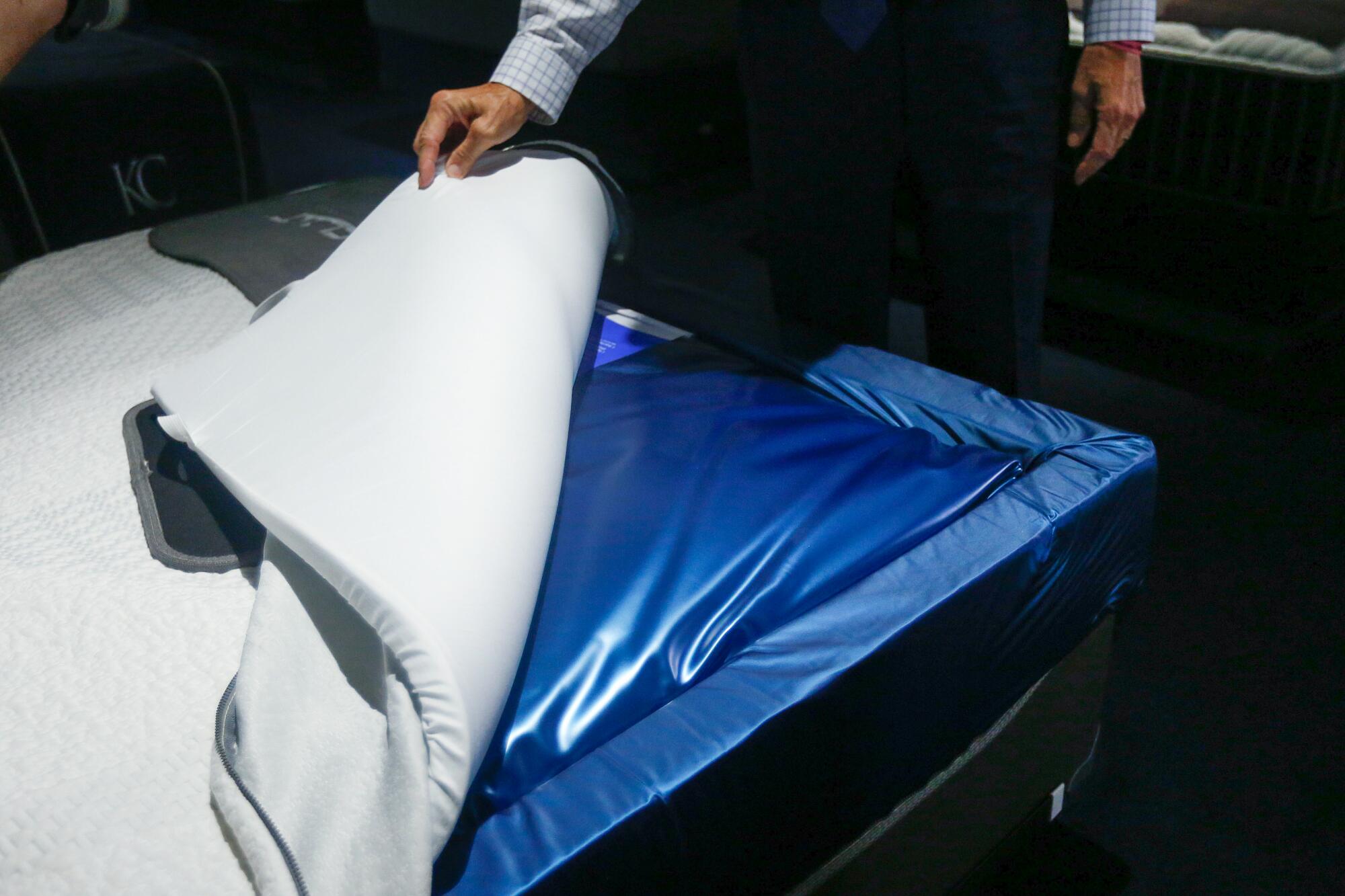
Steve Hertzmann, 62, of San Pedro, gets it. He’s been a waterbed devotee for 40 years and is surprised that the wavy mattresses have never made a comeback.
“The best part is in the wintertime when you’re freezing cold,” he said. “The waterbed has a heater, and you hop in and you’re all warm.”
Marty Pojar, who has a store called the Waterbed Doctor in Westminster, would love to see a renaissance, but he thinks the technology needs a rebrand.
“The word ‘waterbed’ creates a stigma,” he said. “When people hear it, they are thinking of the big, old wood-frame waterbeds with lots of wave action.”
Home to four major world-class theme or amusement parks, the Los Angeles area offers plenty of inventive ways to get soaked. From Disneyland to Knott’s and beyond, we rank SoCal’s water rides.
In fact, waterbeds have evolved over the years. Consumers can now pick among mattresses that offer old-school full-motion waves and others that are semi-waveless or have almost no waves at all. Many beds also have two separate water mattresses, one on each side, so if two people are sleeping together and one person gets out of bed, the other doesn’t experience any rocking.
With enough advertising dollars behind it, Pojar thinks renaming waterbeds “flotation sleep systems with temperature control” could bring in new customers.
“Reeducating the public is a big challenge, but there is a big opportunity there, I believe,” Pojar said.
For now, longtime devotees are keeping his business alive. Change can be difficult for a lifelong waterbed fan, as Larry Johnson of Mar Vista has learned firsthand.
The accountant slept on a waterbed for 50 years, until May, when his wife convinced him that a standard mattress would make it easier to get out of bed as they age.
A few days in, Johnson was on the fence. The “dead bed” was not as soft as his waterbed. He missed the rocking motion.
“It’s going to take some getting used to,” he said.
More to Read
Sign up for The Wild
We’ll help you find the best places to hike, bike and run, as well as the perfect silent spots for meditation and yoga.
You may occasionally receive promotional content from the Los Angeles Times.


